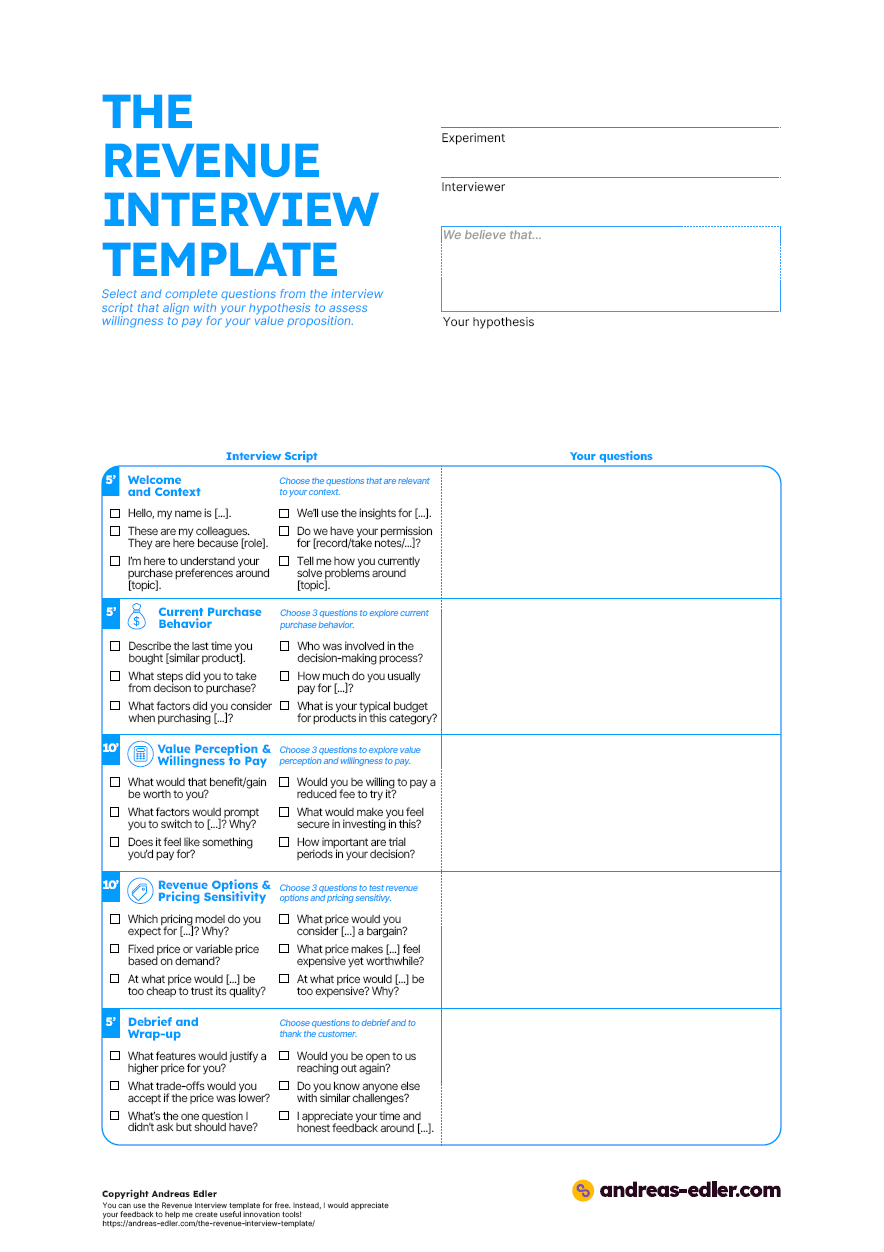The Revenue Interview Template
Uncover what customers are truly willing to pay for.
Current Purchase Behavior Questions
The questions below help you understand your customer’s current and past purchase behavior and expectations.
Understanding customer purchasing behavior reveals spending patterns, decision-making processes, and budget constraints. These insights help you align your revenue model with customer expectations and reduce adoption friction.
1. Purchase Process & History
Uncovers customer preferences, decision triggers, and barriers to purchase.
- Recent Purchase Experience:
“Can you describe the last time you purchased a product or service similar to this?”
Reveals real-life behavior, detailing the steps and context of the purchase. - Purchase Process Mapping:
“What steps did you follow from the moment you decided to buy until you completed the purchase?”
Helps map the buying process and highlights any friction points. - Channel Preferences:
“Which channels did you use for that purchase (e.g., online, in-store, through a sales rep), and what influenced your choice?”
Identifies preferred purchasing channels that could be leveraged. - Decision Triggers:
“What triggered you to decide that it was time to buy?”
Pinpoints the events or needs that initiate purchasing, guiding your marketing and sales strategies. - Hesitations and Barriers:
“Were there any obstacles or hesitations you encountered during the process?”
Uncovers potential barriers that you might address with your solution. - Improvement Opportunities:
“Were there any aspects of the buying process that you felt could have been improved to make your decision easier or faster?”
Gathers insights on what could remove friction and add value to the customer journey. - Influence of Research:
“How did you research your options before buying, and what sources or recommendations did you trust the most?”
Identifies touchpoints and information sources that have the most influence over decision-making.
2. Purchase Decision
Determines what drives their purchase behavior and what objections you may need to overcome.
- Decision Criteria:
“What factors do you typically consider when deciding to invest in a new product or service around [topic]?”
Identifies key decision criteria that guide purchase behavior. - Influencers & Stakeholders:
“Who else is usually involved in or influences the decision-making process for purchasing solutions related to [topic]?”
Reveals additional decision-makers and key influencers. - Risk & Concern Barriers:
“Have concerns ever prevented you from investing in a new solution? If so, what were they?”
Identifies perceived risks and hesitation points that could block a sale. - Hesitation Due to Uncertainty:
“Can you describe a time when uncertainty about the value or performance of a solution made you delay or avoid a purchase?“
Provides insight into specific doubts that might need to be addressed. - Confidence Boosters:
What would give you the confidence to commit to a purchase when evaluating a new solution?”
Identifies the reassurances or guarantees needed to overcome objections. - Proof Points & Value Evidence:
“What kind of proof points or information do you need to be convinced that a solution is worth the investment?“
Reveals the evidence or metrics that are most convincing in proving value. - Evaluation Process:
“How do you typically compare different options when evaluating new solutions?”
Sheds light on their decision process and what differentiates one option from another. - Switching Triggers:
“What factors or improvements would make you consider switching from your current solution to something new?“
Identifies key triggers for switching, which helps you frame your value proposition around those factors. - Investment Decision Factors:
“When evaluating a new tool, what key performance indicators or ROI metrics are most important to you?”
Focuses on the tangible benefits that justify the purchase, aiding in positioning your value proposition. - Pricing Sensitivity:
How does pricing factor into your decision-making process, and what budget range do you typically allocate for solutions like this?”
Helps assess price sensitivity and whether the perceived value meets their investment threshold. - Post-Purchase Reflection:
Have you ever experienced buyer’s remorse after investing in a new product or service? What factors contributed to that feeling?”
Uncovers potential long-term objections and issues related to post-purchase satisfaction. - After-Sales Support:
How important is after-sales support or customer service when making your purchase decision?”
Identifies additional factors that could influence overall confidence in the solution.
3. Pricing & Budget
Allows you to set optimal pricing strategies that maximize revenue.
- “How much do you usually pay for products or services like this?”
Provides a baseline for price expectations and affordability. - “Can you walk me through how you decide if the price of a product is worth it?”
Uncovers criteria used to evaluate value relative to cost. - “Which pricing model do you typically prefer for solutions like this (one-time fee, subscription-based, or usage-based)?“
Design your revenue stream in line with what they expect and find most comfortable. - “Can you describe a recent purchase you made for a similar solution and why you chose that price point?“
Provides concrete examples of past spending, offering a benchmark for your own pricing strategy. - “What is your typical budget for products or services in this category?”
Establishes the spending range and helps in setting realistic price points. - “How does your organization or personal budget typically allocate funds for solutions like this?“
Clarifies the financial context and whether the potential cost fits within their existing spending habits. - “How often do you allocate budget for these kinds of purchases?”
Determines purchase frequency, critical for recurring revenue models. - “Have you ever been frustrated by the pricing structure of a product you use? If so, what was the issue?“
Identifies pain points in current pricing, which could signal opportunities for improvement. - “Have you ever abandoned a purchase due to pricing issues or a complicated payment process?“
Indicates pain points that might cause lost revenue opportunities.

You can use The Revenue Interview Template for free. Instead, I would appreciate your feedback after at least 15 interviews to help me create useful innovation tools!